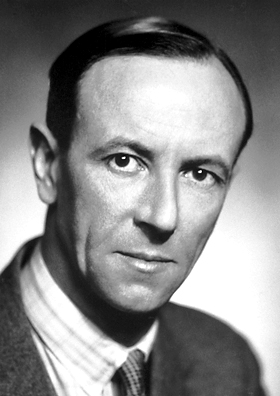<Back to Index>
- Physicist James Chadwick, 1891
- Architect Christopher Wren, 1632
- 1st President of Kenya Jomo Kenyatta, 1894
PAGE SPONSOR

Sir James Chadwick CH FRS (20 October 1891 – 24 July 1974) was an English Nobel laureate in physics awarded for his discovery of the neutron.
Chadwick was born in Bollington, Cheshire, to John Joseph Chadwick and Anne Mary Knowles. He went to Bollington Cross C of E Primary School, attended the Central Grammar School for Boys in Manchester, and then studied at the Universities of Manchester and Cambridge.
In 1913 Chadwick went and worked with Hans Geiger at the Technical University of Berlin. He also worked with Ernest Rutherford. He was in Germany at the start of World War I and was interned in Ruhleben P.O.W. Camp just outside Berlin. While he was interned, he had the freedom to set up a laboratory in the stables. With the help of Charles Ellis he worked on the ionization of phosphorus and also on the photo-chemical reaction of carbon monoxide and chlorine. He spent most of the war years in Ruhleben until Geiger's laboratory interceded for his release. In 1932, Chadwick discovered a previously unknown particle in the atomic nucleus. This particle became known as the neutron because of its lack of electric charge. Chadwick's discovery was crucial for the fission of uranium 235. Unlike positively charged alpha particles, which are repelled by the electrical forces present in the nuclei of other atoms,
neutrons do not need to overcome any Coulomb barrier and can therefore
penetrate and split the nuclei of even the heaviest elements. For this
discovery he was awarded the Hughes Medal of the Royal Society in 1932 and the Nobel Prize for Physics in 1935. Chadwick’s discovery made it possible to create elements heavier than uranium in the laboratory. His discovery particularly inspired Enrico Fermi, Italian physicist and Nobel laureate, to discover nuclear reactions brought by slowed neutrons, and led Lise Meitner, Otto Hahn and Fritz Strassmann, German radiochemists in Berlin, to the revolutionary discovery of “nuclear fission”. Chadwick became professor of physics at Liverpool University in 1935. As a result of the Frisch-Peierls memorandum in 1940 on the feasibility of an atomic bomb, he was appointed to the MAUD Committee that investigated the matter further. He visited North America as part of the Tizard Mission in
1940 to collaborate with the Americans and Canadians on nuclear
research. Returning to England in November 1940, he concluded that
nothing would emerge from this research until after the war. In
December 1940 Franz Simon, who had been commissioned by MAUD, reported that it was possible to separate the isotope uranium-235. Simon's report included cost estimates and technical specifications for a large uranium enrichment plant.
James Chadwick later wrote that it was at that time that he "realised
that a nuclear bomb was not only possible, it was inevitable. I had to
then take sleeping pills. It was the only remedy." He shortly afterward joined the Manhattan Project in the United States, which developed the atomic bombs dropped on Hiroshima and Nagasaki. Chadwick was knighted in 1945. In 1940, Chadwick forwarded to the Royal Society the work of two French scientists, Hans Von Halban and Lew Kowarski,
who worked in Cambridge. He asked that the papers be held as they were
not appropriate for publication during the war. In 2007, the Society discovered the documents during an audit of their archives.